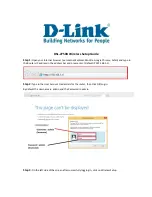
WG102-500, WGAP150 ProSafe 802.11g Wireless Access Point Reference Manual
2-2
Configuration
v1.0, February 2009
shows the general access point settings.
Table 2-1. General Access Point Settings
Field
Descriptions
AP Name
A user-specified name for the access point.
This value can be retrieved via SNMP.
Location
A user-specified name for the location of the access point.
This value can be retrieved via SNMP.
AP Mode
This pulldown menu allows you to select the access point to run as a bridge or a
router. When the access point runs as a router, the Management VLAN ID is
ignored and the LAN settings appears for proper network setup.
Domain Name
The domain name can be set for wireless clients to have a readable name for both
web management and captive portal redirection URLs.
Server IP
The unique IP address for the wireless access point to communicate on the
Ethernet segment. This IP address is distinct from the admin IP address
192.168.0.3 on the Ethernet segment.
There are two check boxes:
•
From DHCP
. The IP address of the wireless access point is acquired from a
DHCP server on the Ethernet segment.
•
Keep Default IP
. The default IP address is available on the system along with
the Server IP setting.
Subnet Mask
The subnet mask of the wireless access point.
Default Gateway.
The default gateway of the wireless access point.
DNS Server
The DNS server address to be used by the wireless access point for resolving host
names.
Management VLAN ID
The VLAN from which management sessions are allowed. The establishment of
management sessions is restricted to only the specified VLAN ID. If Management
VLAN ID is set to zero, no VLAN restriction is applied. The default value of this
setting is zero, which means no tagging is enabled (instead of tagged with zero).
Timezone
This pulldown menu allows you to select the time region for the wireless access
point.
NTP Server
The Network Time Protocol (NTP) Server host name to be used for synchronizing
the system clock of the wireless access point. The default value of this setting is
pool.ntp.org.
STP
Select the
STP
check box to enable the Spanning Tree Protocol (STP) to prevent
path redundancy. When the STP check box is selected, two more options are
provided:
Bridge Priority
and
Ethernet Path Cost
.
Bridge Priority
The priority for root switch election.
Ethernet Path Cost
The best path from the switch to the root switch.
FullManual.book Page 2 Thursday, January 29, 2009 10:12 AM
















































